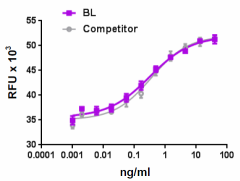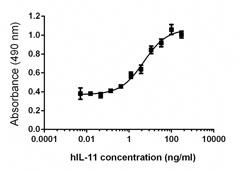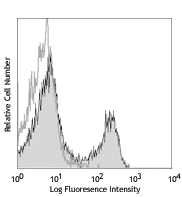- Regulatory Status
- RUO
- Other Names
- OSM
- Ave. Rating
- Submit a Review
- Product Citations
- publications

-

Recombinant human oncostatin M induced the proliferation of human erythroleukemic TF-1 cells in a dose dependent manner. BioLegend’s protein was compared side-by-side a competitor’s equivalent product.
Human oncostatin M (OSM) was initially isolated from supernatant of U937 cells treated with PMA. It was identified by its property to inhibit the proliferation of A375 melanoma cells and other human tumor cells. Bioinformatic homology analysis reveals that OSM has a similar composition and structure to LIF, G-CSF, and IL-6. OSM and LIF are located on human chromosome 22, and additional evidence suggests that these genes were derived by duplication of a common ancestral gene. In fact, many of its biological functions are shared with LIF. OSM binds two types of OSM receptor (OSMR) complexes. The type I receptor complex is composed of gp130 (IL-6 signal transducer) and LIF receptor β (LIFRβ) subunits. The type II receptor is constituted by the gp130 receptor and the OSMR β-chain. OSM also shares the OSMRβ-chain with the IL-31 receptor complex. The OSMRβ subunit is expressed by fibroblast, endothelial, hepatic, lung, and hematopoietic cells. The proinflammatory properties of OSM have been reported in skin, adipose tissue, lung, heart, and liver tissues. OSM triggers acute phase protein synthesis in hepatocytes. OSM is a potent inhibitor of keratinocyte proliferation and decreases the expression of both early and late keratinocyte differentiation markers. OSM transcripts are elevated in skin from psoriasis and atopic dermatitis patients, as compared with healthy skin. OSM and its receptor complexes play a key role in cutaneous inflammatory responses. In addition, OSM expression is increased in colonic biopsies of patients with active inflammatory bowel disease.
Product DetailsProduct Details
- Source
- Human Oncostatin, amino acids (Ala26-Arg221) (Accession# NM_020530), was expressed in E. coli.
- Molecular Mass
- The 196 amino acid recombinant protein has a predicted molecular mass of approximately 22.1 kD. The DTT-reduced and non-reduced protein migrate at approximately 20 kD and 22 kD, respectively, by SDS-PAGE. The predicted N-terminal amino acid is Ala.
- Purity
- >95%, as determined by Coomassie stained SDS-PAGE.
- Formulation
- 0.22 µm filtered protein solution is in PBS, 5mM Citric Acid, pH 3.5.
- Endotoxin Level
- Less than 0.01 ng per µg cytokine as determined by the LAL method.
- Concentration
- 10 and 25 µg sizes are bottled at 200 µg/mL. 100 µg size and larger sizes are lot-specific and bottled at the concentration indicated on the vial. To obtain lot-specific concentration and expiration, please enter the lot number in our Certificate of Analysis online tool.
- Storage & Handling
- Unopened vial can be stored between 2°C and 8°C for up to 2 weeks, at -20°C for up to six months, or at -70°C or colder until the expiration date. For maximum results, quick spin vial prior to opening. The protein can be aliquoted and stored at -20°C or colder. Stock solutions can also be prepared at 50 - 100 µg/mL in appropriate sterile buffer, carrier protein such as 0.2 - 1% BSA or HSA can be added when preparing the stock solution. Aliquots can be stored between 2°C and 8°C for up to one week and stored at -20°C or colder for up to 3 months. Avoid repeated freeze/thaw cycles.
- Activity
- Human Oncostatin M induces the proliferation of human TF-1 cells in a dose-dependent manner. The ED50 for this effect is 0.2 to 1.0 ng/mL.
- Application
-
Bioassay
- Application Notes
-
BioLegend carrier-free recombinant proteins provided in liquid format are shipped on blue-ice. Our comparison testing data indicates that when handled and stored as recommended, the liquid format has equal or better stability and shelf-life compared to commercially available lyophilized proteins after reconstitution. Our liquid proteins are verified in-house to maintain activity after shipping on blue ice and are backed by our 100% satisfaction guarantee. If you have any concerns, contact us at tech@biolegend.com.
Antigen Details
- Structure
- Cytokine
- Distribution
-
Activated monocytes, macrophages, T cells including skin-infiltrating T cells, and dendritic cells.
- Function
- Proinflammatory mediator and keratinocyte activator, induces acute phase protein synthesis, hematopoiesis, and bone remodeling.
- Interaction
- Keratinocytes, fibroblasts, endothelia, hepatic cells, lung, hematopoietic cells, epithelial cells, and smooth muscle cells.
- Ligand/Receptor
- Receptor complex: type I and type II complexes are formed by oncostatin M receptor (OSMR), LIFR, and p130 (IL-6 signal transducer).
- Cell Type
- Embryonic Stem Cells, Hematopoietic stem and progenitors
- Biology Area
- Cell Proliferation and Viability, Immunology, Stem Cells
- Molecular Family
- Cytokines/Chemokines, Growth Factors
- Antigen References
-
1. Zarling JM, et al. 1986. Proc. Natl. Acad. Sci. USA 83:9739.
2. Rose TM and Bruce AG. 1991 Proc. Natl. Acad. Sci. USA 88: 8641.
3. Mosley B, et al. 1996. J. Biol. Chem. 271:32635.
4. Dillon SR, et al. 2004. Nat. Immunol. 5:752.
5. Boniface K, et al. 2007. J. Immunol. 178:4615.
6. Beigel F, et al. 2014. PLoS One 9:e93498.
7. Schnittker D, et al. 2013. Mediators Inflamm. 2013:317503. - Gene ID
- 5008 View all products for this Gene ID
- UniProt
- View information about Oncostatin M on UniProt.org
Related FAQs
- Why choose BioLegend recombinant proteins?
-
• Each lot of product is quality-tested for bioactivity as indicated on the data sheet.
• Greater than 95% Purity or higher, tested on every lot of product.
• 100% Satisfaction Guarantee for quality performance, stability, and consistency.
• Ready-to-use liquid format saves time and reduces challenges associated with reconstitution.
• Bulk and customization available. Contact us.
• Learn more about our Recombinant Proteins. - How does the activity of your recombinant proteins compare to competitors?
-
We quality control each and every lot of recombinant protein. Not only do we check its bioactivity, but we also compare it against other commercially available recombinant proteins. We make sure each recombinant protein’s activity is at least as good as or better than the competition’s. In order to provide you with the best possible product, we ensure that our testing process is rigorous and thorough. If you’re curious and eager to make the switch to BioLegend recombinants, contact your sales representative today!
- What is the specific activity or ED50 of my recombinant protein?
-
The specific activity range of the protein is indicated on the product datasheets. Because the exact activity values on a per unit basis can largely fluctuate depending on a number of factors, including the nature of the assay, cell density, age of cells/passage number, culture media used, and end user technique, the specific activity is best defined as a range and we guarantee the specific activity of all our lots will be within the range indicated on the datasheet. Please note this only applies to recombinants labeled for use in bioassays. ELISA standard recombinant proteins are not recommended for bioassay usage as they are not tested for these applications.
- Have your recombinants been tested for stability?
-
Our testing shows that the recombinant proteins are able to withstand room temperature for a week without losing activity. In addition the recombinant proteins were also found to withstand four cycles of freeze and thaw without losing activity.
- Does specific activity of a recombinant protein vary between lots?
-
Specific activity will vary for each lot and for the type of experiment that is done to validate it, but all passed lots will have activity within the established ED50 range for the product and we guarantee that our products will have lot-to-lot consistency. Please conduct an experiment-specific validation to find the optimal ED50 for your system.
- How do you convert activity as an ED50 in ng/ml to a specific activity in Units/mg?
-
Use formula Specific activity (Units/mg) = 10^6/ ED50 (ng/mL)
 Login / Register
Login / Register 














Follow Us